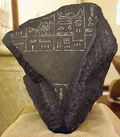Top Qs
Timeline
Chat
Perspective
T (hieroglyph)
Egyptian hieroglyph From Wikipedia, the free encyclopedia
Remove ads
The ancient Egyptian Bread bun hieroglyph is Gardiner sign listed no. X1 for the side view of a bread bun. It is also the simple shape of a semicircle. The hieroglyph is listed under the Gardiner category of loaves and cakes.
The bread bun hieroglyph is used in the Ancient Egyptian language hieroglyphs for the alphabetic consonant letter t.[1] A later alternative t, is a pestle, with curved top, Gardiner U33.
Look up 𓏏 in Wiktionary, the free dictionary.

Remove ads
"Bread bun/semi-circle" as feminine determiner
Besides alphabetic-t, the bread bun is used for words that are feminine, as an end qualifying determinative, often shown before other qualifying ideograms or determinants in the hieroglyphic word block-(quadrat hieroglyphic block). It is one of the most frequently used signs in hieroglyphic writing.
Palermo Stone
Summarize
Perspective
The t hieroglyph is used extensively throughout the Palermo Stone of the 24th to 23rd century BC, and it is used in the first row (Row I of VI), for the naming of King Tiu of Lower Egypt (a King of the North).
Palermo Stone, King Series, Row I (predynastic)
The following is the list of predynastic pharaohs (Nile Delta north) represented on the Palermo Piece of the 7–piece Palermo Stone: The sequence is in the proper order with the beginning Pharaoh on the right: (reading right-to-left, seven complete names pictured in year-registers):
- Owl...Papyrus...Ripple......Tether...Bread&Feather.Bivalve...Cloth
- Belly.....Fish......Plow........Lake.............Quail.........Newborn...Ka
Note: On the Palermo Stone all the hieroglyphs face in the other direction (Gardiner signs are only facing left; on the stone they face right (reading right-to-left)). The source of the following Pharaohs is only from this King List; a few have artifacts that further confirm their reign (the Double Falcon King). The pharaohs deficient in information are: Hsekiu, Khayu, Tiu (pharaoh), Thesh, Neheb, Wazner, Mekh.
- Narmer Palette detail, from late 3rd millennium Ancient Egypt
- Nile River flood levels recorded on 1-piece of the 7—piece Palermo Stone. Note the 2-uses of t.
- Palermo piece (at Palermo Museum), of the 7—piece Palermo Stone
Remove ads
The Egyptian hieroglyph alphabetic letters
The following two tables show the Egyptian uniliteral signs. (24 letters, but multiple use hieroglyphs)
| a |
y |
' |
(w,u) |
B | |||||||||||
| P |
M |
N |
R |
H1 | |||||||||||
| H2 |
Kh2 |
S |
(Sh)=Š |
Q/K2 | |||||||||||
| K |
T |
Ch—Tj |
D |
Dj | |||||||||||
| L/(R) (special) (Ptolemaic, etc.) |
-- | -- | -- | -- |
| a | i (ee) |
y ii |
' ah, (aïn) |
w, (u) (oo) |
B | |||||||||||||||||
| P | F | M | N | R | H1 | |||||||||||||||||
| H2 | (Kh)1 | (Kh)2 | S | Sh (Sh) |
K emphatic | |||||||||||||||||
| K | G | T | Tj Ch Tsh |
D | Dj | |||||||||||||||||
| (additionally 4 for vert/horiz) |
-- | -- | -- | -- | -- | |||||||||||||||||
M (horiz) M2-Plinth |
N (vert) (see: N (red crown)) |
S (vert) S (folded) cloth) |
M (3rd-M -2nd-vert) M3-Baker's tool (vertical) | |||||||||||||||||||
| (additionally 3 for equivalents) |
-- | -- | -- | -- | -- | |||||||||||||||||
is—
y2-Two strokes |
is—
letter w, u (see w2-Coil) |
T (no. 2) T2-Pestle |
See also
References
Bibliography
Wikiwand - on
Seamless Wikipedia browsing. On steroids.
Remove ads



